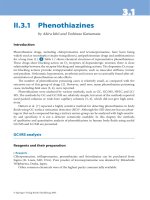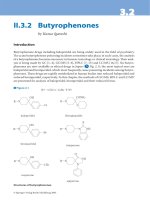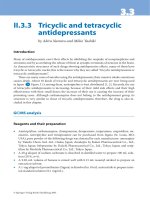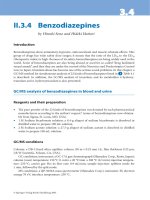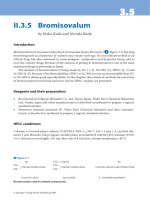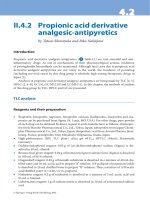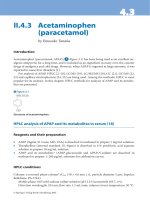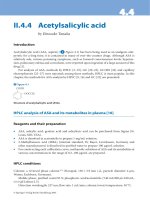Tài liệu Drugs and Poisons in Humans - A Handbook of Practical Analysis (Part 46) pptx
Bạn đang xem bản rút gọn của tài liệu. Xem và tải ngay bản đầy đủ của tài liệu tại đây (129.59 KB, 6 trang )
5.45.4
© Springer-Verlag Berlin Heidelberg 2005
II.5.4 Permethrin
by Naoto Matsumoto
Introduction
Pyrethroids are the general term for insecticide pyrethrins and their analogs ( cinerins and
jasmolins) being included in the owers of pyrethrum or chrysanthemum. Trace concentra-
tions of pyrethroids exert rapid toxic e ects on insects, but are rapidly metabolized for detoxi-
cation in warm-blooded animals; they are insecticides with very high safety for humans.
On the basis of clari cation of chemical structures of the e ective components of the pyre-
thrum, many of new synthetic pyrethroids were developed. Nowadays, the natural pyrethroids
are almost replaced by the synthetic ones. ey are not only being used for household insecti-
cides, but also being used in agriculture worldwide. ey count about 1/3 of the total insecti-
cides, and are even increasing at the present time.
Products containing pyrethroid insecticides are numerous; their toxicities for humans
are generally low. However, since phenotrin, permethrin and empenthrin are ubiquitous as
powders, emulsions and moth repellants for clothes, there are possibilities of their accidental
and suicidal ingestion.
Permethrin
a
(> Figure 4.1) [3-phenoxybenzyl(1RS)-cis, trans-3-(2,2-dichlorovinyl)-2,2-
dimethylcyclopropane-1-carboxylate] is one of the pyrethroids with the lowest toxicities and
being used very widely; the author et al. [1] experienced an actual case of ingestion of a large
amount of permethrin-containing emulsion (Adio
®
, Agros, Tokyo, Japan) and measured the
concentrations of its cis and trans isomers in blood and gastric juice. In this chapter, a method
of HPLC analysis for permethrin in serum is presented.
Structure of permethrin.
⊡ Figure 4.1
Reagents and their preparation
• Pure cis- and trans-permethrin isomers can be obtained from Wako Pure Chemical Indus-
tries, Ltd., Osaka, Japan; the mixture of the isomers from ICN (Costa Mesa, CA, USA). In
the case of the mixture, the con rmation of the composition ratio is essential.
• e standard permethrin methanolic solution is prepared at 1–10 µg/mL and stored in a
light-shading bottle.
426 Permethrin
• Other common chemicals are of the special or HPLC grade. e water
b
to be used for a
mobile phase or pretreatments should not be stored in a plastic container, but be stored in
a glass one.
HPLC conditions
HPLC column
c
: Bensil 5C
18
-C (15 cm × 4.6 mm i.d., Bentec, Chiba, Japan; guard column:
LiChrospher PR 18e (4 × 4 mm i.d., Merck Japan, Tokyo, Japan).
HPLC conditions; instruments
d
: LC-10A; data processor: C-R4A (Shimadzu Corp., Kyoto,
Japan); column temperature: 40 °C; mobile phase: acetonitrile/0.01 M K
2
HPO
4
(pH 6.5,
adjusted with phosphoric acid) (75:25, v/v); ow rate: 1.0 mL/min; detection wavelength
e
:
UV 210 nm.
Procedure
i. Permethrin is a lipophilic compound. When a plastic blood-collecting tube containing a
serum-separating agent is used for sampling a small amount of blood, permethrin is easily
adsorbed to the serum-separating agent ( polyole n or polystyrene), causing low recoveries
of this compound. For samplings of blood specimens, usual glass blood-collecting tubes
should be used.
ii. A 100-µL volume of serum and 200-µL acetonitrile are placed in a 500-µL volume polypro-
pylene tube, vortex-mixed for 10 s, sonicated for 1 min and centrifuged at 15,000 g for
1 min.
iii. A 100-µL volume of the supernatant solution is injected into HPLC using an auto injector.
iv. When it is within several hours a er ingestion, there is a possibility of the presence
of permethrin in gastric juice; in such cases, gastric juice and/or gastrolavage uid should
be obtained. Either of them is diluted 100–1,000 fold with water/methanol (1:1) for analy-
sis; a 100-µL of the solution is processed in the same way as that of the above serum speci-
men.
v. Construction of a calibration curve: a 10-µL volume each of the standard permethrin solu-
tions (1–10 µg/mL) is placed in a 1.5-mL volume sample tube and evaporated to dryness
under a stream of nitrogen or by leaving it at room temperature. A 1-mL volume of serum
is added to each residue and vortex- mixed for 10 s; a 100-µL each of the spiked sera at
various concentrations is processed according to the above procedure. e external cali-
bration method is used for quantitation using peak areas
f
.
Assessment and some comments on the method
Since the toxicity of permethrin is low, its poisoning cases are few; the reports on chromatog-
raphic analysis of permethrin in human blood are very limited [1]. ere are reports on anal-
ysis by HPLC or GC (GC/MS) for permethrin in foods (oil [2], milk [3] and grain [4]), chemi-
cal products (shampoo and lotion [5]), biological specimens (rat plasma and urine [6–8]) and
environmental water [9].
427Permethrin
For toxin screening by GC/MS, such analysis becomes possible using gastric juice and/or
gastrolavage uid, if it is within several hours a er ingestion. e gastric juice or gastrolavage
uid is diluted 100–1,000 fold with methanol; a 1–2 µL aliquot of the solution is injected into
GC/MS. e GC/MS conditions are; column: a methylsilicone chemical-bonded capillary
column; column temperature: 50 °C → 15 °C/min → 300 °C; scan range: m/z 50–400. Under
these conditions, the isomers of permethrin can be separated; cis-permethrin appears earlier
than trans-permethrin. A er identi cation of permethrin in gastric juice or gastrolavage uid,
its quantitative analysis can be done by HPLC.
In this method, the deproteinization is being employed using a water-soluble organic
solvent
g
; it is accomplished only by the addition of 2 volumes of acetonitrile to serum. Such
simplicity of the procedure results in good reproducibility; the intra-day CV values are not
greater than 3 %.
e detection wavelength
e
is set at 210 nm. e absorbance ratios are: 200/210 nm = 1.32;
220/210 nm = 0.68; 260/210 nm = 0.036; 270/210 nm = 0.048; 280/210 nm = 0.039. e ab-
sorbance is higher at shorter wavelengths. When the interference by impurities of serum and
the sensitivity are taken into consideration, the wavelength at 210 nm is optimal.
> Figure 4.2
shows HPLC chromatograms for permethrin in sera of a patient, who had ingested a large
amount of permethrin emulsion.
e recovery of permethrin from serum was 95.0 % at 500 ng/mL of the spiked concentra-
tion. Good linearity could be obtained in the range of 50–1,000 ng/mL. e detection limit was
20 ng/mL (S/N = 3).
e advantages of the use of the reversed phase HPLC for analysis of permethrin in serum
are the simplicity of pretreatments and rapidness of analysis; it seems more useful than GC in
clinical analysis.
HPLC chromatograms for extracts of sera obtained from a permethrin-poisoned patient 3 h and
3 months after admission.
⊡ Figure 4.2
428 Permethrin
For more sensitive analysis, the condensation of permethrin using Sep-Pak C
18
[6] (Waters,
Milford, MA, USA) or Extrelut (Merck, Darmstadt, Germany) extraction becomes necessary.
Poisoning case, and toxic and fatal concentrations
A 59-year-old male [1] attempted suicide by ingesting 600 mL of 20 % permethrin emulsion
(Adion
®
) and sent to a hospital under clouding of his consciousness. He had had a past history
of mania-depression and renal dysfunction. Upon the rst examination, his consciousness
level was 100 (JCS), and incontinent diarrhea with whitish water-like stools, which gave a in-
secticide-like smell, was observed. e laboratory tests showed high values of BUN and creati-
nine probably due to metabolic acidosis and renal dysfunction. By treatments, such as endotra-
cheal intubation, gastrolavage, administrations of activated charcoal and magnesium citrate
and transfusion, his conditions were improved; a er 15 h, his consciousness became clear and
the metabolic acidosis was improved. On day 11, he was transferred to the psychiatric depart-
ment.
e concentrations of permethrin isomers were: trans-form 96 ng/mL and cis-form 118 ng/
mL upon admission; trans-form 253 ng/mL and cis-form 615 ng/mL reaching the maximum
levels a er 3 h; the levels decreased therea er. e areas under the curves (AUC) of perme-
thrin at 24 h a er ingestion were 2,700 and 6,280 ng
·
h/mL for trans- and cis-forms, respec-
tively; the trans/cis ratio of the AUC was 0.43 (trans/cis concentration ratio for the Adion
®
emulsion, 1.30). is shows faster blood clearance of the trans-form of permethrin than that of
the cis-form in humans.
e metabolic rate of the trans-form of permethrin is faster than that of the cis-form also
in rats and mice; the residual permethrin in cow milk is higher for the cis-form than for the
trans-one [10]. ese data are in agreement with those of the patient.
Notes
a) e structures of the cis- and trans-forms of permethrin are due to di erent locations of the
dichlorovinyl group and of the carboxylic acid ester group against the plane of the dimethyl-
cyclopropane ring. In addition, there are optical isomers (1 RS) for each form, which can
be separated only with a column having a chiral activity.
b) e mobile phase conditions for HPLC analysis of permethrin are similar to those for plas-
ticizers to be used for production of plastics. is means that the permethrin measure-
ments may be interfered by plasticizers in HPLC chromatograms; such interference should
be taken into consideration, especially when an isocratic mode is changed into a gradient
mode.
c) For separation, any column packed with porous silica gel (particle size, 5 µm) chemically
bonded by ODS (C
18
) (carbonization rate, about 15 %) can be used. If the size of the column
is the same (15 cm × 4.6 mm i.d.), similar separation property can be obtained.
d) For HPLC and its data processor, a system, which enables the storage of data in FD or HDD
and various manipulations of peaks such as magni cation, reduction and other changes on
CRT, is most preferable. Without such a system, the sensitivity becomes about 5 times
lower (detection limit, about 100 ng/mL).
429Permethrin
e) When a UV detector is used for HPLC analysis, the setting of a wavelength is very impor-
tant; it is desirable to use a longer wavelength to avoid the interference by biological
impurities. e UV absorbance is dependent on the π bond (π electrons). e location
of absorption maximum has a regular relationship with the presence of conjugated
double bonds (conjugated ole n), and with the kinds and the number of substituents
for the unsaturated carbonyl compounds ( Woodward rule). e more conjugated double
bonds give more shi of absorbance toward a longer wavelength (from UV to visible
ranges). UV absorption spectra of compounds having phenyl groups like permethrin
show λ
max
at 260 °C 280 nm; there is a trend that lower absorbance of a compound is
obtained for a lower ratio of phenyl group(s) to the molecular size. When a detection
wavelength is set at 200–220 nm, the absorbance becomes higher. However, in this range
of wavelengths, the absorbance due to an impurity compound having a single double-
bond appears; such absorbance due to impurities interferes with that of a target com-
pound. erefore, it is not necessary to set a detection wavelength at λ
max
of the com-
pound; it is more important to avoid the interference by absorbance of impurity com-
pounds, and it is most preferable to select a wavelength, which is highly speci c to a target
compound.
f) For quantitation of a compound by HPLC, the internal or external calibration method is
being utilized using peak heights or peak areas. Peak heights are very susceptible to degra-
dation of a separation column or a guard column, and to the increase of dead volumes due
to undesirable piping; peak areas are much more resistant to these problems and thus give
better reproducibility.
g) When deproteinization is performed by using a water-soluble organic solvent for the
pretreatment of a biomedical specimen such as serum, followed by centrifugation to
obtain clear supernatant extract to be directly injected into reversed phase HPLC, there is
a possibility of deformation of a peak shape (leading and/or decrease in the number of
theoretical plates). is phenomenon is due to the solvent of a specimen to be injected into
HPLC; it appears when the elution ability of the solvent is higher than that of the mobile
phase. e solvent makes a part of a compound eluted faster. In this method, the deprotein-
ization with acetonitrile gave 67 % acetonitrile extract solution. erefore, such e ect may
appear, when the content of acetonitrile in the mobile phase is lower than 67 % (using
columns of ODS with a low carbonization ratio or columns of a chemical-bonded octyl or
phenyl group).
References
1) Gotoh Y, Kawakami M, Matsumoto N et al. (1998) Permethrin emulsion ingestion: clinical manifestations and
clearance of isomers. J Toxicol Clin Toxicol 36:57–61
2) Ramesh A, Balasubramanian M (1998) Rapid preconcentration for the determination of pyrethroid insecticides
in vegetable oils and butter fat and simultaneous determination by gas chromatography-electron capture
detection and gas chromatography-mass spectrometry. Analyst 123:1799–1802
3) Di Muccio A, Pelosi P, Barbini DA et al. (1997) Selective extraction of pyrethroid pesticide residues from milk by
solid-matrix dispersion. J Chromatogr A 765:51–60
4) Dicke W, Ocker HD, Their HP (1988) Residue analysis of pyrethroid insecticides in cereal grain, milled fractions
and bread. Z Lebensm Unters Forsch 186:125–129
5) Garcia E, Garcia A, Barbas C (2001) Validated HPLC method for quantifying permethrin in pharmaceutical for-
mulations. J Pharm Biomed Anal 24:999–1004
